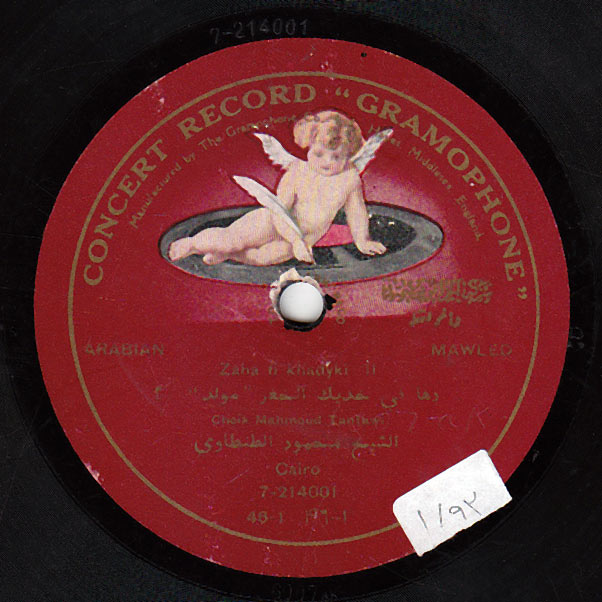Images
All images are courtesy of AMAR Foundation

search

All images are courtesy of AMAR Foundation

The tawshīḥ (2)
The Arab Music Archiving and Research foundation (AMAR), in collaboration with the Sharjah Art Foundation (SAF), presents Durūb al-Nagham
We presented and discussed in our previous episode two types of tafrīd: tafrīd through tarannum and tafrīd on the tawshīḥ’s lyrics.
We will start today’s episode with the third type of tafrīd, i.e. tafrīd with other lyrics’ than the tawshīḥ’s lyrics:
The solo munshid inserts poetry or prose foreign to the composed text while the biṭāna’s performance is halted for longer than the usual duration required by tawshīḥ improvisation. Usually, the inserted texts are related to an event, such as mawlid al-nabī, the month of Ramadan, the isrā’ night (the night journey), or the ḥadīth around the birth of a certain imam.
Let us listen to Sheikh Ṭāh al-Fashnī chanting tawshīḥ Mawlāya katabta raḥmat al-nāsi ‘alēk to the sīkāh maqām, which we already heard in an abridged version. We will now listen to a longer version in order to note:
how solo forms are affixed onto the same melody;
the relation of the solo munshid with his biṭāna: how he signals them to go back to the same verse or to shift to a new verse by stopping his tafrīd, and how they receive his signal.
In the third verse of the tawshīḥ, Sheikh Ṭāh inserted verses about the month of Ramadan starting with the tuqa month (month of piety), as a tadhkīr…
(♩)
The same as in dawr, early 20th century composers started to author their muwashshaḥ to both sub-maqām and compound maqām equally. The most famous of those who used compound maqām include Sheikh ‘Alī Maḥmūd.
Let us listen to tawshīḥ Bi-rabbika yā man to the kardān sīkāh, a rāst sub-maqām, composed by Sheikh ‘Alī Maḥmūd and performed by him with his biṭāna, recorded late in 1926 by Odeon on two sides of a 27cm record, # X 55580, 1 and 2, matrix # xE 3066 and xE 3067.
Note his relation with his biṭāna that produced great composers and munshid, including Sheikhs Zakariyyā Aḥmad, Ṭāh al-Fashnī, Muḥammad al-Fayyūmī, and ‘Abd al-Sammī‘ al-Bayyūmī, among others who learned from him before becoming independent munshid…
(♩)
Most tawshīḥ are composed to the middle waḥda or the major waḥda, some to the minor waḥda, and few to a‘raj rhythms or odd number rhythms such as the dārij and the dawr hindī.
Among those, let us listen to tawshīḥ Dhahā fī khaddayk al-khafar to the 3-pulse’ dārij, ḥiṣār maqām — a ‘ushshāq ‘arabī sub- maqām — performed by Sheikh Maḥmūd al-Ṭanṭāwī, and recorded around 1919 by Gramophone on one side of a 25cm record, # 7-214001, matrix # 6007 ak…
(♩)
At the beginning of the recording era, tawshīḥ were recorded without any instrumental accompaniment, while some ibtihāl (litanies) were recorded with instruments in the same manner as qaṣīda mursala chanting. On the other hand, we only know of Sheikh ‘Alī Maḥmūd and Ibrāhīm al-Farrān’s tawshīḥ — made around the same period, i.e. in the late 1920s — that were recorded with an instrumental accompaniment.
Let us now listen to Sheikh Ibrāhīm al-Farrān and his biṭāna performing tawshīḥ Mā shamamtu al-warda composed by Sheikh Zakariyyā Aḥmad to the sīkāh maqām, accompanied by the takht of Sāmī al-Shawwā (kamān), ‘Abd al-Ḥamīd al-Quḍḍābī (qānūn), and Maḥmūd Raḥmī (percussions), recorded electrically around 1928 by Odeon on two sides of a 25cm record, # 1368-1 and 1368-2, matrix # 785 EK and 786 EK…
(♩)
The tawshīḥ is among the rare forms composers continued to derive melodies from. Indeed, tawshīḥ are still being composed to our day… maybe because the tawshīḥ is the most unfettered by the restrictions of a form.
We end today’s episode with Sheikh Muḥammad al-Fayyūmī and his biṭāna chanting tawshīḥ Amdaḥ al-mukammal, composed by Sheikh Muṣliḥ al-Ḥarīrī to the nahāwand maqām — a ‘arabī ‘ushshāq sub-maqām —, recorded by the Egyptian radio in the 1960s.
We will meet again in a new episode of Durūb al-Nagham.